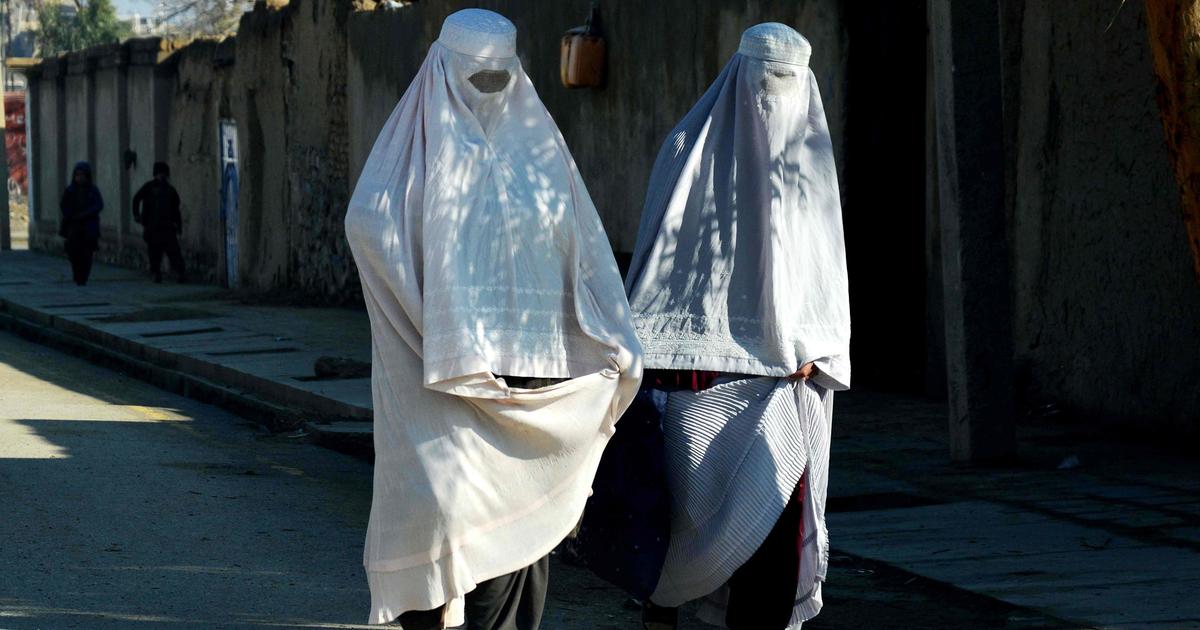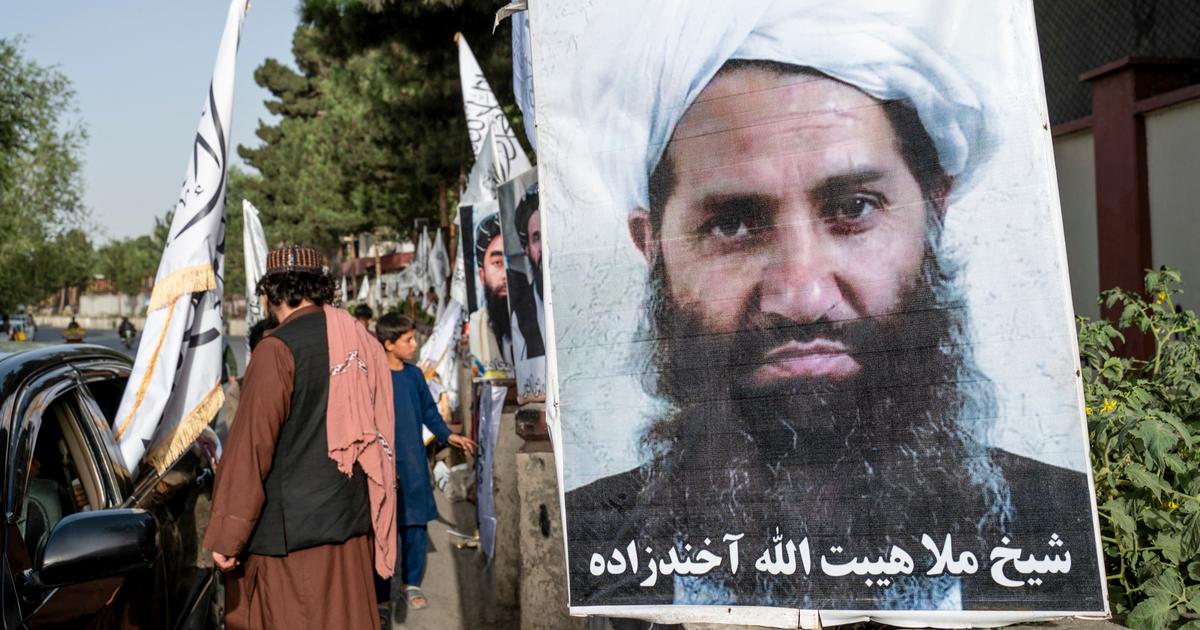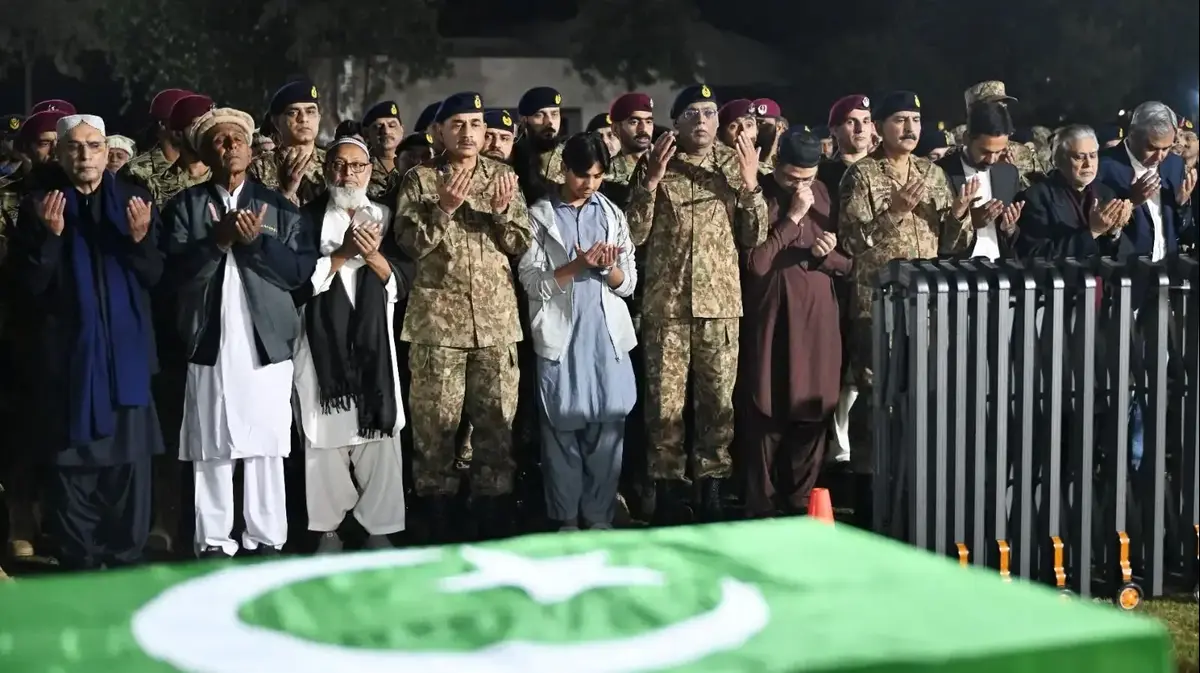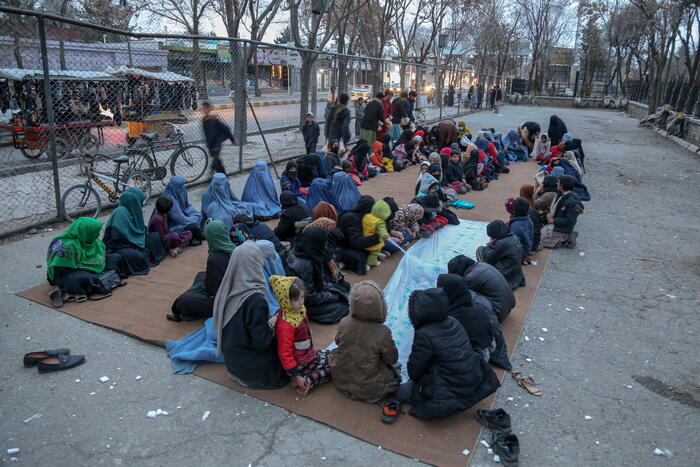One summer morning in 1999, Shukriya Barakzai woke up dizzy and with a fever. According to Taliban rules, he needed a maharram, a guardian, to go to the doctor. Her husband was working, and she had no sons. So he shaved his two-year-old daughter's head, dressed her in boy's clothes to pass her off as his guardian, and donned a burqa. The blue folds of the garment covered her nails, painted red despite the prohibition imposed by the Taliban. She asked her neighbor to accompany her to the doctor, in the center of Kabul. At 4.30 in the afternoon, they left the office with a prescription. They were heading to a pharmacy when a truck of Taliban militants from the Ministry for the Propagation of Virtue and for the Prevention of Vice pulled up beside them.These groups routinely moved around Kabul in pickup trucks looking for Afghans to humiliate and punish in public for breaking their moral code.
Photogallery: The struggle of women in Afghanistan, in pictures
The men jumped out of the truck and began beating Barakzai with a rubber cable.
They kept doing it even after she fell to the ground.
When they left her, she got up, crying.
She was outraged and humiliated.
Until then, she had never been beaten.
"Does something we call sadism ring a bell?" Barakzai asked me recently when we spoke.
“It's like they don't know why, like they're just trying to hit you, hurt you, disrespect you.
Now that's what they enjoy.
Not even they know the reason ”.
Clandestine wedding held in Herat in 2001 in which the Titanic soundtrack and Iranian music were danced Lynsey Addario
He attributes the birth of his life as an activist to that moment.
Before the capital of Afghanistan plunged into civil war in 1992, Barakzai was studying hydrometeorology and geophysics at the University of Kabul.
When the Taliban, then a relatively new militia, emerged victorious in 1996, they forced Afghan women out of their studies.
While recovering from the beating, Barakzai made a decision: He would organize clandestine classes for girls in the spacious apartment complex where he lived with his family and 45 other families.
Later, he would help draft the Afghan constitution and hold a seat in Parliament for two terms.
Join EL PAÍS now to follow all the news and read without limits
Subscribe here
I first traveled to Afghanistan in May 2000, when I was 26 years old. At the time I was living in India, covering South Asian women's issues as a photojournalist, and I was curious about how women lived during the Taliban regime. Afghanistan was then emerging from a brutal 20-year conflict - first the Soviet occupation and then a protracted civil war - that had left Kabul full of sinkholes and little functioning infrastructure. By the mid-1990s, the Taliban had vowed to end the violence, and many Afghans, exhausted from years of insecurity and constant destruction, offered no resistance to the Islamic fundamentalist group. But peace came at the cost of losing social, political and religious freedoms.
When I made my first visit, the Taliban had applied their interpretation of sharia, Islamic law. They prohibited the education of women and girls in virtually all circumstances, and women (except select licensed doctors) were not allowed to work outside the home, or even go out without a male guardian. Those who left were required to wear a burqa. Any form of entertainment was prohibited for all: music, television, gatherings of both sexes outside the family. Most of the educated Afghans had already fled to neighboring Pakistan and elsewhere; those who stayed had to change their lives, to adapt it to the dictates of the oppressive regime.
Dr. Zubeida, a midwife with the UNFPA-funded mobile health unit, provides prenatal and anti-natal care and counseling to Afghan women in the village of Charmas, a remote area of Badakshan, Afghanistan, on 9 August 2009. Lynsey Addario
As a single American, I needed to find a way to move around Afghanistan with someone to act as a husband, and take photos without being seen (the Taliban had forbidden photographing any living thing). I contacted the United Nations High Commissioner for Refugees, one of the few international organizations that continued to function in Afghanistan, and the Comprehensive Program for Mutilated Afghans, a United Nations agency whose objective was to rehabilitate those injured by the many antipersonnel mines laid throughout the country. The groups arranged for men to serve as escorts, as well as drivers and translators, to traverse Ghazni, Logar, Wardak, Nangarhar, Herat and Kabul provinces in order to surreptitiously photograph and interview Afghans.I immediately understood the advantages of being a female photojournalist, despite the difficulties: I had free access to them in spaces prohibited for men.
From May 2000 to March 2001, over the course of three separate trips, I moved with my cameras and films hidden in a small bag, visiting private homes, women's hospitals, secret schools for girls. I attended clandestine wedding celebrations with guests of both sexes, in which the Titanic soundtrack rumbled off the concrete walls as heavily made-up men and women (with painted fingernails) danced in a display of sheer delight; a simple pleasure punishable by execution under a regime that controlled the streets outside.
Perhaps what lingers most in my mind is the silence of life with the Taliban. There were very few cars, no music, no television, no telephones, no idle conversation on the sidewalks. The dusty streets were full of widows who had lost their husbands in the long war; Unable to work due to prohibition, his only way to survive was by begging. People were afraid, inside and outside the home. Those brave enough to venture out spoke in whispers, for fear of provoking a beating from the Taliban for something as simple as not having a beard long enough (in the case of men) or a burqa long enough (in the case of women). , or, sometimes, for nothing at all. Bright cassette tapes hung billowing from trees, cables, signs, and poles everywhere,a warning to those who dare to play music in private. Matches at Kabul's Ghazi Stadium had been replaced by public executions on Prayer Fridays. Taliban authorities used bulldozers or tanks to tear down walls on men accused of being gay. Those accused of adultery were stoned to death.
Three Afghan policewomen receive training at a shooting range by Italian Caribinieri on the outskirts of Kabul, Afghanistan, April 13, 2010 Lynsey Addario
During these trips, I observed the strength and resilience of the Afghan women.
I often wondered what would become of Afghanistan if the Taliban fell.
I imagined that the men and women who offered me that hospitality, that humor, and that strength would flourish, and that Afghans who had fled the country would finally be able to return home.
Months later came the attacks of September 11, 2001, and shortly after, the invasion of Afghanistan. The Taliban fell and the women quickly proved that they were invaluable in the work of rebuilding and leading the country. A great wave of optimism, determination and faith in the development and future of Afghanistan broke out. But, as the Taliban again faded into the fabric of cities and villages, many of their conservative values, with deep roots in Afghan society, persisted.
I photographed the defeat of the Taliban in Kandahar in late 2001, and returned to the country with my camera at least a dozen times in the next two decades. From Kabul to Kandahar, via Herat or Badahshan, I have photographed women attending classes, graduating from universities, training as surgeons, giving birth, working as midwives, running as candidates for Parliament and working in government, driving, training for being policemen, acting in films, working - as journalists, translators, television presenters - for international organizations. Many facing the impossible act of combining work outside the home and raising children; being a wife, mother, sister or daughter in a place where women broke glass ceilings on a daily basis, and sometimes at great risk.
Several women graduate in language arts from Kabul University, 2010 Lynsey Addario
One of the people I met in my travels was Manizha Naderi, co-founder of Women for Afghan Women.
For more than a decade, her organization helped establish in Afghanistan a network of shelters and family mediation services, counseling and legal aid for Afghan women with family problems, victims of abuse or incarcerated without a defense lawyer.
Naderi now lives with her family in New York.
When we spoke recently, I asked him if he thought things had improved for Afghans in the past two decades.
"Without a doubt," he replied. “Before the US invaded Afghanistan, there was nothing there, no infrastructure, no judicial system, no education system, nothing. In the last 20 years, the country has re-created everything, from education, the judicial system, society, the economy ... women have won everything. Not only women, but also Afghans in general have gained a lot. "
Now, of course, those advances will disappear.
Last week, the Taliban took over almost every major city in the country;
on Sunday, his forces entered Kabul, and President Ashraf Ghani fled the country.
Militants have opened prison doors and released thousands of prisoners, sending women home from work, and withdrawing girls from schools.
In the advance towards the capital, his forces have destroyed medical facilities, killed civilians, and left thousands of Afghans displaced.
Some claim that the Taliban demand that women in the villages they conquer marry their unmarried fighters (although the group denies this).
A burqa-clad beggar woman stops a car looking for money on the streets of Kabul, Afghanistan, in May 2000 Lynsey Addario
Fawzia Koofi, another woman I have met in Afghanistan, has dedicated her life to her country since the Taliban came to power in 1996. She too created a secret network of girls' schools in the 1990s, in her Badakhshan home province. Koofi was a parliamentarian between 2005 and 2019, and has been one of the representatives of the Republic of Afghanistan in the peace negotiations with the Taliban prior to the withdrawal of US troops from the country. When I first met her in 2009, she was moving through Kabul followed by a small crew of male advisers and a security detail, returning home from long days in Parliament to find a line of voters at her door begging her to listen to their concerns. She was also raising two young daughters alone;her husband had died in 2003 of tuberculosis, acquired in the jails of the Taliban. Koofi seemed never to stop, not even to tire. The Taliban have tried to assassinate her three times. He always carried a handwritten letter to his daughters with him, just in case.
When I called Koofi a few weeks ago in Kabul, the Taliban were already gaining ground in the country. Koofi was skeptical of promises made by the group that they would maintain women's freedoms to study and work outside the home. He cited a complete disconnect between what Taliban officials were saying during the peace negotiations in Qatar and the human rights violations that his contacts told him that foot soldiers were committing on the ground. I asked him if he was afraid. "Honestly, I am not afraid of being murdered," he replied. "What I fear is that the country will fall into chaos again."
As the Taliban invaded cities across Afghanistan, Koofi spent much of his time answering calls from men and women terrified of the repercussions of the takeover. It frustrated him how little he could offer by way of comfort. Shortly before I spoke with Koofi, a pregnant woman had called her from Faizabad, the capital of Badakhshan, a place I visited in 2009 to document the high rates of maternal mortality in the province. Over the past decade, several advances have lowered that number. The woman who called Koofi needed to deliver by caesarean section, but the Taliban were closing in and she feared she would not be able to access a hospital for the operation. She only had three weeks left until her due date, and she had no way to leave home.What could I do? If she didn't have a C-section, the woman could die, but Koofi had no way of helping her from Kabul. Last week, Faizabad fell into the hands of the Taliban.
Recently, the price of burqas has doubled, and in some cases it has risen even more.
Women are buying the best armor to protect themselves from the Taliban: the veil.
Before the Taliban came to power, these four women had worked.
In May 2000, when these photos were taken, working Afghan women were relegated to a life at home. Lynsey Addario
At the weekend, when the Taliban were besieging Kabul, I asked Koofi how she was doing and if she had been evacuated.
She fled her home on Sunday and is now hiding in Afghanistan.
"Nobody helps us," he told me.
"Can you talk to the Americans?"
I get WhatsApp messages like this daily from former performers and models for my photos, expressing fear and wondering how to get out of Afghanistan.
I don't know is my answer. I don't know where you can go. I don't think the United States will continue to help. No, I don't think they will give you, or your brother or my driver for 11 years, a visa. I don't know what will happen to women in Afghanistan.
All I know is that the women I have known these last 20 years have amazed me with their determination and resourcefulness. They have made me collapse with laughter and tears. I think of the cool afternoon in 2010 when I was driving through Kabul as a co-driver in the car of an Afghan actress. Her beautiful face, completely made up, and her hair were in plain sight as she played Iranian music at full volume and danced with her hands around the wheel. He passed checkpoints, loads of burqas, and amazed and disdainful men. She was laughing, and I was laughing, thinking how far the Afghans had come. The Taliban cannot take the last 20 years from the Afghans; his education, his desire to work, his taste for freedom.
And today there is a new generation of Afghans, women who do not remember what it is to live under the Taliban.
"They are full of energy, hope and dreams," Shukriya Barakzai told me.
“They are not like me, like I was 20 years ago.
They are more alert.
They are communicating with the world ”.
The Taliban conquer territory, says Barakzai, "but not the hearts and minds of the people."
Two girls in a beauty salon, dressed and made up for a relative's wedding in Kabul, 2009 Lynsey Addario
Lynsey Addario is a photojournalist and author of
Of Love and War
and
It's What I Do
, her memoirs as a reporter for
The New York Times
.
© 2021 The Atlantic Monthly Group.
All rights reserved.
Distributed by Tribune Content Agency, LLC.
Translation of News Clips.



/cloudfront-eu-central-1.images.arcpublishing.com/prisa/KA3LQ5ZEAFEQXOIZXJEEVDUZUQ.jpg)





